 “Poet John Keats could have been writing about the landscapes painted by these four men when he said, ‘A thing of beauty is a joy forever,’” said U.S. Postal Service Vice President of Delivery and Post Office Operations Ed Phelan Jr. in dedicating the stamps. “These stamps are beautiful, and they are Forever Stamps. They will always be good to send a card or letter, no matter what the postage rate might be. They will last into the future, much like the paintings they honor.”
“Poet John Keats could have been writing about the landscapes painted by these four men when he said, ‘A thing of beauty is a joy forever,’” said U.S. Postal Service Vice President of Delivery and Post Office Operations Ed Phelan Jr. in dedicating the stamps. “These stamps are beautiful, and they are Forever Stamps. They will always be good to send a card or letter, no matter what the postage rate might be. They will last into the future, much like the paintings they honor.”Joining Phelan in the dedication were American Philatelic Society (APS) Board of Vice Presidents Chairman Alexander Haimann; APS Executive Director Ken Martin; APS President Stephen Reinhard; U.S. Postal Service Citizens’ Stamp Advisory Committee member Katherine Tobin; U.S. Postal Service Director of Stamp Services and Corporate Licensing Susan McGowan; Connecticut District Manager David Mastroianni; and Hartford Postmaster Leeann Theriault.
The stamps are 12th in the U.S. Postal Service’s American Treasures series. They feature paintings of Distant View of Niagara Falls by Thomas Cole (1801-1848); Summer Afternoon by Asher B. Durand (1796-1886); Sunset by Frederic Edwin Church (1826-1900); and Grand Canyon by Thomas Moran (1837-1926). The designer and art director for these stamps was Derry Noyes of Washington, DC.
The Hudson River School Art Movement
During the 19th century, the artists of a young America searched for a new world view and found it in the very landscapes around them. Inspired by the stunning natural beauty of New York state and Arizona’s Grand Canyon, the loose-knit Hudson River School of painters flourished from the mid-1830s to the mid-1870s and gave America its first major school of art. (See detailed background on each artist at the end of the news release).

Thomas Cole is represented by Distant View of Niagara Falls from the collection of the Art Institute of Chicago. The painting shows two Native Americans on a rocky ledge in front of a pristine and idealized view of the falls that, at the time Cole painted it in 1830, were surrounded by factories, scenic overlooks and tourist hotels. “But great, glorious, and sublime Niagara — wonder to the eye of man — I do not wish to disparage thee,” Cole wrote in 1846. “Thou hast a power to stir the deep soul.”
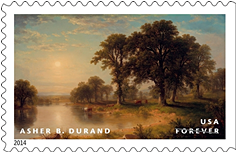
Asher B. Durand is represented by the 1865 painting Summer Afternoon, now in the collection of the Metropolitan Museum of Art in New York City. Commissioned by Morris Jessup, a prominent railroad banker and first president of the American Museum of Natural History, the painting earned praise from art critic Henry Tuckerman two years after its creation: “The sky, the atmosphere, the vegetation and especially the noble group of trees, all breathe an air of quiet brooding, warmth and repose.”
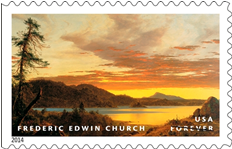
Frederic Edwin Church is represented by the 1856 painting Sunset, from the collection of the Munson-Williams-Proctor Arts Institute in Utica, NY. The painting is on loan to The Taft Museum in Cincinnati until Sept. 14, 2014. Inspired by one of many summer trips to the area around Mount Katahdin, ME, this idealized scene offers a fine example of Church’s ability to create dramatic and convincing depictions of sunlight.
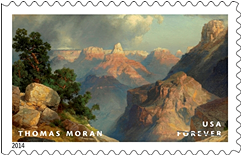
Thomas Moran is represented by the 1912 painting Grand Canyon, from the collection of the Nelson-Atkins Museum of Art in Kansas City, MO. The painting embodies Moran’s ability to convey scenes that are both idealized, but also recognizable to people who have seen the actual landscape themselves. “My aim,” Moran said in 1878, “was to bring before the public the character of the region.”
The Hudson River School stamps are being issued as Forever stamps and will always be equal in value to the current First-Class Mail 1-ounce price.
Many of this year’s other stamps may be viewed on Facebook at facebook.com/USPSStamps,via Twitter @USPSstamps or at beyondtheperf.com/2013-preview.
First-Day-of-Issue Postmarks
Customers have 60 days to obtain the first-day-of-issue postmark by mail. They may purchase stamps at a local Post Office, The Postal Store at usps.com/stamps, or by calling 800-STAMP-24. Customers should affix the stamps to envelopes of their choice, address the envelopes to themselves or others, and place them in larger envelopes addressed to:
Hudson River School
Hartford Post Office
MOWU
141 Weston Street
Hartford, CT 06101-9998
After applying the first-day-of-issue postmark, the Postal Service will return the envelopes through the mail. While the first 50 postmarks are free, there is a five-cent charge per postmark beyond that. All orders must be postmarked by Oct. 20, 2014.
First-Day Covers
The Postal Service also offers first-day covers for new stamp issues and Postal Service stationery items postmarked with the official first-day-of-issue cancellation. Each item has an individual catalog number and is offered in the quarterly USA Philatelic catalog, online atusps.com/stamps or by calling 800-782-6724. Customers may request a free catalog by calling 800-782-6724 or writing to:
United States Postal Service Catalog Request
PO Box 219014
Kansas City, MO 64121-9014
Philatelic Products
Eight philatelic products are available for this stamp issue:
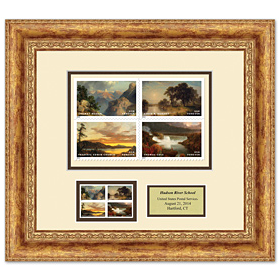
689524 Framed Art, $39.95.

689506 Press Sheet w/Die cut, $39.20 (quantity printed 1,000).
689508 Press Sheet w/o Die cut, $39.20 (quantity printed 1,500).

689510 Digital Color Postmark Keepsake (set of 4), $16.95.

689516 First-Day Cover (Set of 4), $3.72.
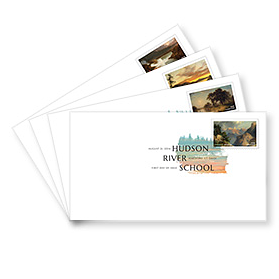
689521 Digital Color Postmark (Set of 4), $6.56.
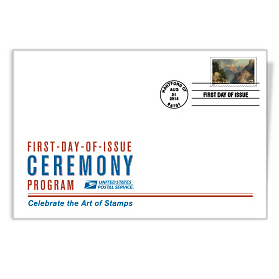
689530 Ceremony Program, $6.95.
689531 Stamped Deck Card, $0.95
Hudson River School Artists Background
Thomas Cole
Renowned for imbuing his landscapes with a strong sense of allegory and narrative, Thomas Cole is considered the unofficial founder of the Hudson River School.
Born in England, Cole came to the United States with his family when he was 17, working as a wood engraver in Philadelphia and holding a job at his father’s wallpaper business in Ohio before teaching himself to paint. In 1825, Cole traveled up the Hudson River to the Catskill Mountains and turned his sketches into landscape paintings that caught the eye of Colonel John Trumbull, a famous painter of the American Revolution, who helped usher the artist into prominent New York cultural circles.
After a trip to Europe, Cole painted many Italian subjects, but increasingly found inspiration in Catskill Mountains subjects. Through his dramatic style, he strove to capture the wild side of nature, which he believed could bring humanity closer to God. “The delight such a man experiences is not merely sensual, or selfish, that passes with the occasion leaving no trace behind,” Cole wrote in 1836, “but in gazing on the pure creations of the Almighty, he feels a calm religious tone steal through his mind, and when he has turned to mingle with his fellow men, the chords which have been struck in that sweet communion cease not to vibrate.”
Cole stressed that all of his countrymen stood to benefit from beholding scenes of their homeland: “It is a subject that to every American ought to be of surpassing interest; for, whether he beholds the Hudson mingling waters with the Atlantic — explores the central wilds of this vast continent, or stands on the margin of the distant Oregon, he is still in the midst of American scenery — it is his own land; its beauty, its magnificence, its sublimity — all are his; and how undeserving of such a birthright, if he can turn towards it an unobserving eye, an unaffected heart!”
Asher B. Durand
Known for his appreciation for vivid natural detail and vistas bathed in golden light, Asher B. Durand encouraged Americans to see the landscapes around them as rich sources of artistic and spiritual inspiration.
Born in New Jersey, Durand studied engraving under his father and became an engraver’s apprentice. In his early 20s, as one of the leading engravers and printmakers in New York City, he produced banknotes and illustrations — until the mid-1830s, when Thomas Cole inspired him to pursue painting.
After painting portraits and historical subjects, Durand exhibited several prominent landscapes inspired by an 1837 trip to the Adirondack Mountains with Cole. In 1841, he returned from a stint in Europe and focused on paintings of the Catskills and other areas of the Hudson River Valley, seeing unique and infinite potential in the nature of America: “The ‘lone and tranquil’ lakes embosomed in ancient forests, that abound in our wild districts, the unshorn mountains surrounding them with their richly-textured covering, the ocean prairies of the West, and many other forms of Nature yet spared from the pollutions of civilization, afford a guarantee for a reputation of originality that you may elsewhere long seek and find not.”
Durand was one of the founders of the organization that became the National Academy of Design, and served as its second president from 1845 to 1861. In a series of “Letters on Landscape Painting” published in 1855 in the New York art journal The Crayon, he set down the basic beliefs and values of the Hudson River School. Like Cole, he saw landscape painting as a sort of religious experience, and he argued that American artists should work directly from nature and not look to Europe for inspiration. “Go not abroad then in search of material for the exercise of your pencil, while the virgin charms of our native land have claims on your deepest affections,” Durand insisted. “Many are the flowers in our untrodden wilds that have blushed too long unseen, and their original freshness will reward your research with a higher and purer satisfaction.”
Frederic Edwin Church
Connecticut-born Frederic Edwin Church studied art with Cole in the Catskill Mountains in the mid-1840s, but soon developed his own unique style. Known for his incredible precision, Church dazzled viewers with paintings that were massive in size, meticulous in detail and conveyed a sense of the sublime.
In his New York City studio, Church combined sketches of various New York and New England locations into landscape paintings. In the 1850s, inspired by the travels of naturalist and explorer Alexander von Humboldt, he traveled in Colombia and Ecuador. The resulting paintings, which included a gigantic depiction of the Andes, secured his reputation as one of the greatest landscape painters of his generation. A public exhibit of a Church painting was an event that drew thousands or even tens of thousands of viewers: In 1857, one famous 7-foot-wide painting so stunned the public that a New York newspaper was moved to declare: “It is a view of Niagara Falls which will cause all others ever painted to be forgotten.”
In search of new sights, Church sketched icebergs in the North Atlantic. When the loss of his two children to diphtheria in 1865 sent the grief-stricken artist and his wife to Jamaica, he painted gorgeous scenes of vegetation under distinctive tropical light. Later travels followed, but in the 1870s, Church and his family took up permanent residence in the Hudson River Valley, where he built Olana, an estate with a magnificent view of the Catskills. Around his new home, now a New York State Historic Site, Church designed a garden landscape that won acclaim as a work of art in its own right. “The hand of man generally improves a landscape,” he wrote. “The earth has been given to him, and his presence in Eden is natural; he gives life and spirit to the garden.”
Thomas Moran
Through his travels and the sketches and paintings that resulted, English-born artist Thomas Moran is associated with the American West, especially Yellowstone and the Grand Canyon.
As a child, Moran moved with his family to suburban Philadelphia, where he loved to sketch in the nearby woods. After studying art in Europe and establishing himself as a painter, engraver and illustrator, Moran became intrigued by illustrations he was asked to rework for an 1871Scribner’s article about Yellowstone. Later that year, he joined Ferdinand V. Hayden’s geological survey expedition to the West and soon found the landscapes he was born to paint.
At Yellowstone, Moran made field sketches and watercolor studies of hot springs, geysers, waterfalls and other natural features, later using them as the basis for large studio paintings. Moran’s works were the first color images of Yellowstone ever seen by residents of the eastern United States, and they proved highly influential: His paintings and the photographs of friend and fellow expedition member William Henry Jackson greatly impressed Congress and are credited with hastening the 1872 establishment of Yellowstone as America’s first national park.
Moran continued to travel throughout the American West, becoming so synonymous with the Western frontier that the Santa Fe Railroad used his likeness in advertisements. He later sought artistic inspiration in Europe, Cuba and Mexico, and became well known for his Long Island landscapes and coastal scenes, which continued his tendency to convey the impression of a place rather than offer a scientifically accurate likeness. “I place no value upon literal transcripts from Nature,” he explained. “My general scope is not realistic; all my tendencies are toward idealization… Topography in art is valueless.” In the early 20th century, a writer for the Kansas City Star hailed Moran’s career as the perfect pairing of artist and subject: “Thomas Moran is confessedly America’s greatest landscape painter, as he is also the painter of America’s greatest landscapes.”









